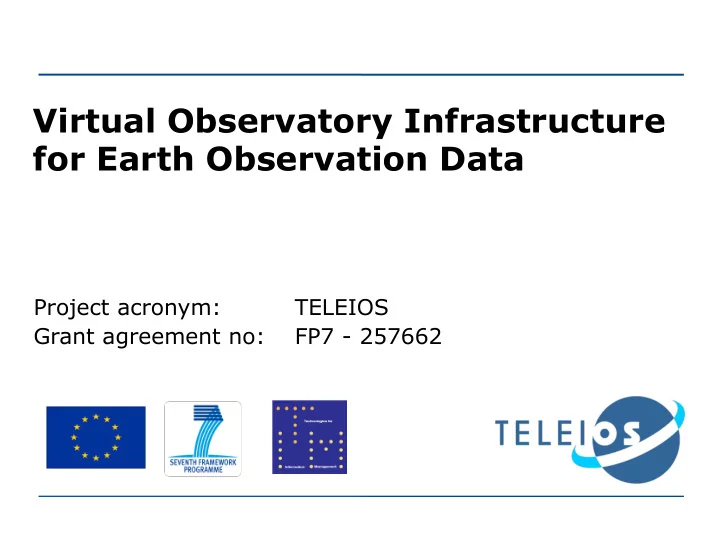

Virtual Observatory Infrastructure for Earth Observation Data Project acronym: TELEIOS Grant agreement no: FP7 - 257662
Motivation • Satellite Earth Observation facts: • Existing satellites send to earth around 100GB per day. • The amount of data available (petabytes) outstrips the human intelligence available to exploit it. • Opportunity/Challenge: Enable the use of EO data by an even larger group of applications by maximizing the automation of relevant processes. • Our response: TELEIOS Project
Project summary • Design and implement a Virtual Observatory infrastructure for EO data (an Earth Observatory). • Demonstrate the TELEIOS infrastructure in two use cases: • Use Case I: A Virtual Observatory for TerraSAR-X data. • Use Case II: Real-time fire monitoring based on continuous acquisitions of EO images and geospatial data.
Project overview 36 month work programme structured into: 10 work packages: • • WP1-WP5: Research and software development • WP6-WP8: Use cases and involving the user community • WP9: Management • WP10: Dissemination 4 phases: • • Phase I: User requirements • Phase II: Foundational research on data models and languages • Phase III: First version of the TELEIOS infrastructure • Phase IV: Final version and evaluation of the TELEIOS infrastructure
Technical innovation and objectives • Advancing the state of the art in satellite image mining, scientific databases, GIS, and Semantic Web technologies!
Technical innovation and objectives To define a data model and query language for EO images based on • the concept of a multidimensional array (WP2). To develop a scalable, robust, and adaptive environment for know- • ledge discovery from EO images and geospatial data sets (WP3). To define a semantics-based data model and language for • specifying and querying EO image annotations capturing not just image metadata but also the knowledge discovered from the images (WP2). To develop query processing and optimization techniques for • queries over multidimensional arrays and EO image annotations and implement them on top of the MonetDB system (WP4, WP5). To integrate all the developed software components into the • TELEIOS infrastructure (WP1). To demonstrate the TELEIOS infrastructure in two use cases (WP6, • WP7).
Dissemination EO scientist community (workshops, continuous evaluation of • TELEIOS technologies) Publications • Demos • Project Web site (http://www.earthobservatory.eu/) • Establishment of close links with other FP7 projects: • • SemsorGrid4Env • GENESIS, GS-SOIL, NatureSDI+, GIGAS • GMES/SAFER • LOD2 and PlanetData • GENESI-DEC Focused research workshops • Interaction with standard bodies (W3C, OGC) •
Consortium • National and Kapodistrian University of Athens (NKUA) • Fraunhofer- Gesellschaft zur Förderung der angewandten Forschung e. V. (Fraunhofer) • Deutsches Zentrum für Luft - und Raumfahrt e.V. (DLR) • Centrum Wiskunde & Informatica (CWI) • National Observatory of Athens (NOA) • Advanced Computer Systems (ACS)
Contact details Manolis Koubarakis – Project Coordinator koubarak at di.uoa.gr +30 210 727 5213 http://www.earthobservatory.eu/
Recommend
More recommend